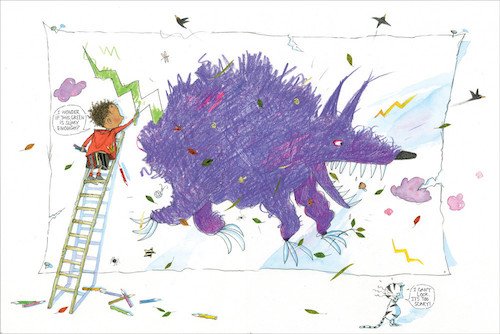Yes. I have one. How do you do it? When I opened Marie-Louise Gay’s newly published Any Questions? for the first time, it was like being handed a bouquet of freshly plucked wildflowers. As I progressed through the book, the room filled with light. I felt uplifted. This is what happens, what always happens, when I read her books. Any Questions? is her most adventurous picture book to date, and certainly her most beautiful. Gay centres the story around her own real-life experience as an author – in particular the many hundreds of questions she is asked (by children) about her books and especially, her creative process:
“How did you learn to draw?”
Where does a story start?
Do you put a cat in every book?
The inquiring minds are represented by Gay’s typical menagerie of whimsically drawn children (no one is better at this), cats, rabbits, and ever-present snails; this time, however, they are not so much characters in the story as the inspiration. Their questions balloon out from the page in one continuous (and utterly charming) conversation, each illustration richly infused with Gay’s luminous watercolour palette. As questions are answered (on the page and in an appendix), Gay invites further participation from her acolytes as she creates a brand new picture book, The Shy Young Giant, itself a thing of sweet wonder in a wonder-filled story. Visually and narratively, there is a lot of bang for your buck in Any Questions. At it’s core, however, is a profound message about valuing curiosity and imagination.
There is a mini-trend this year in children’s books in which the writer directly engages with the characters, and sometimes even the reader, thus breaking the picture book equivalent of the fourth wall. Specifically, The Battle Bunny Book (Jon Scieszka, Mac Barnett) and A Perfectly Messed-Up Story (Patrick McDonnell) bear the marks of having been ‘interfered with’ in the form of scribbles and jam stains courtesy of the ‘reader’. Like these two publications, Marie-Louise Gay plays with the typical format of a picture book, presenting it as an interactive enterprise (albeit with fictional characters), and in doing so, giving us a glimpse into her own creative process. As one might imagine, it’s starts with a blank page, and a question. A lot of questions.
And yet, with the publication of each new book, Gay is becoming more and more playful with her answers. There is a fluidity to her illustrations that is almost dream-like, as if each scene, characters and all, comes tumbling straight from her imagination to the awaiting page – issues resolved, compositions exquisitely realized. As with Gay’s recent books, in Any Questions?, some illustrations are watercolour only, while others take a more multi-media approach, incorporating found paper and bits of text. One senses that Marie-Louise Gay’s internal conversation with an in-progress illustration is loose and chatty. She is open to wherever the story wants to go, and the result, as expressed so beautifully in Any Questions?, is pure joy.
 Marie-Louise Gay is a world-renowned author and illustrator of more than 60 children’s books. She has won many prestigious honours, including two Governor General’s awards and the Marilynn Baillie Picture Book Award. She has also been nominated for the Astrid Lindgren Memorial Award and the Hans Christian Andersen Award, both of which she will surely win one day. Educated at the Institut des arts graphiques in Montreal where she studied graphic design, Gay moved on to the Montreal Museum of Fine Arts School where she majored in animation, followed by illustration studies at the Academy of Art College in San Francisco. Marie-Louise Gay currently lives and works in Montreal when she’s not out and about answering questions.
Marie-Louise Gay is a world-renowned author and illustrator of more than 60 children’s books. She has won many prestigious honours, including two Governor General’s awards and the Marilynn Baillie Picture Book Award. She has also been nominated for the Astrid Lindgren Memorial Award and the Hans Christian Andersen Award, both of which she will surely win one day. Educated at the Institut des arts graphiques in Montreal where she studied graphic design, Gay moved on to the Montreal Museum of Fine Arts School where she majored in animation, followed by illustration studies at the Academy of Art College in San Francisco. Marie-Louise Gay currently lives and works in Montreal when she’s not out and about answering questions.
ANY QUESTIONS? by Marie-Louise Gay. Published by Groundwood Books, 2014
Previously reviewed (click on the link):

















